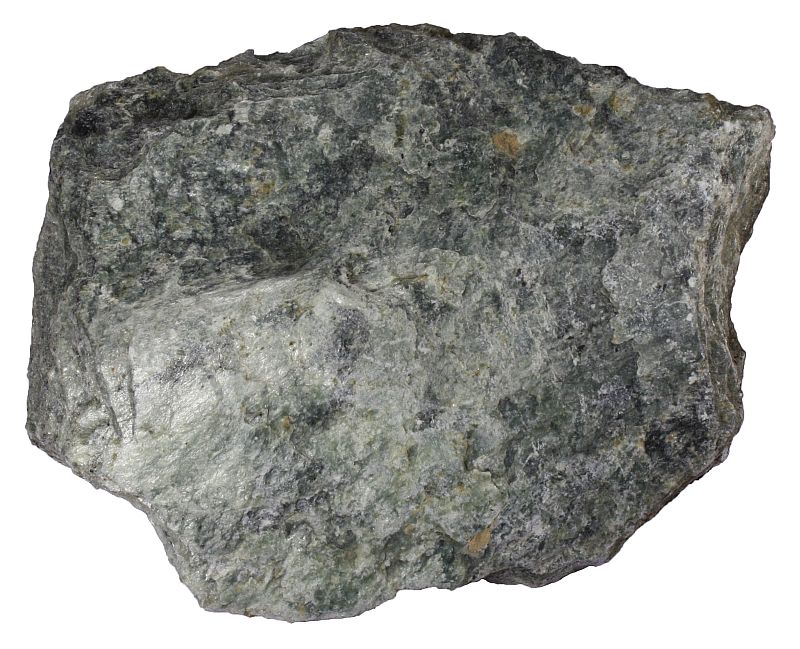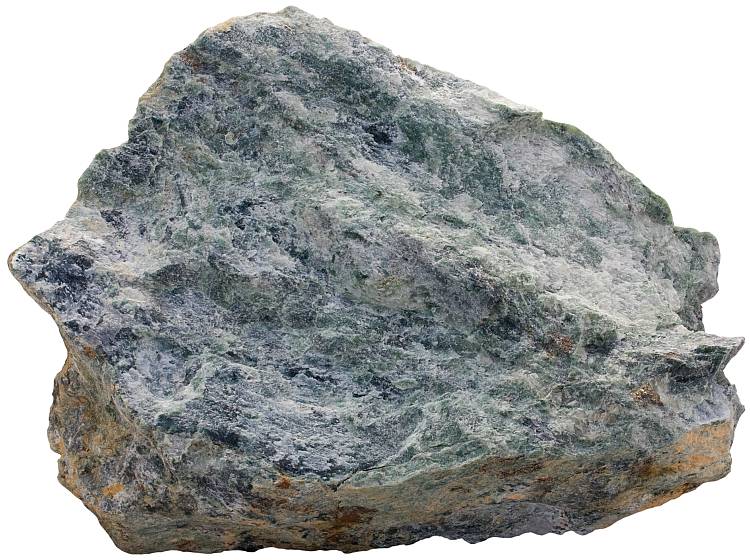Talc is a common mineral in some metamorphic rocks. It is a sheet silicate which means that it is structurally similar to micas and clay minerals. This mineral is always an alteration product, it forms at the expense of other preexisting minerals. The alteration reactions that produce talc are metamorphic — they took place at elevated temperatures and pressures. This is in contrast to chlorite, somewhat similar and often accompanying green-colored sheet silicate mineral group, that may form through metamorphism but also as a weathering product of other minerals.
http://picasaweb.google.com/107509377372007544953/Rocks#5845638661515124434
Talc is very soft and has a greasy feel. Width of sample is 7 cm.
To form it, magnesium and water are needed in addition to silica. The chemical composition is: Mg3Si4O10(OH)2. There are not too many choices available which contain lots of magnesium. These are ultramafic igneous rocks and dolomitic carbonates. OH-group in the chemical formula is a hint that the alteration that produces talc is most likely hydrothermal.
Indeed, this is the case. Talc is a hydrothermal mineral formed often at the expense of serpentine which is also an alteration product of olivine and pyroxenes (common components of ultramafic rocks). Talc may form as dolomite metamorphoses, but in this case the dolomite needs to be impure. Otherwise, the lack of silica will be limiting the growth of talc. It also seems to be a mineral that easily gets pushed aside by other minerals. It forms only when the conditions are just right. If we have Al, Ca or K in the precursor rocks, the formation of chlorite, tremolite or phlogopite (respectively) would be favored. Tremolite is a Ca-bearing amphibole group mineral, phlogopite is a Mg-rich variety of biotite.
Talc is usually light green in color. The most common talc-bearing rocks are talc schist and soapstone. The former is schistose as its name implies and the latter is massive and indeed soapy — its surface is somewhat slippery which is the result of very low hardness. The flakes start slipping in relation to each other if you apply pressure to them with your bare hands, this is what causes the soapy feel.
Talc is so soft that you can scratch it with a fingernail and easily cut with a knife. It is the softest mineral on the Mohs hardness scale with a hardness of 1. However, do not expect that you can easily cut any sample of soapstone (also named steatite) like a bread because they are composed of intergrown crystals and they often contain other minerals as well.
The softness and waxy feel are useful properties that make the identification of the mineral quite easy. Pyrophyllite is similar mineral, it may be very hard to distinguish these two, but pyrophyllite occurs in aluminum-rich rocks (metamorphosed claystones) and it isn’t as widespread.
Talc occurs in sand usually as lithic soapstone or schist fragments, but not for very long because it tends to alter to chlorite.

Talc schist with chlorite from Finland (The Jormua ophiolitic complex). The width of the sample is 10 cm.

Talc schist from Lipasvaara, Finland. Width of sample 14 cm.
The minerals associated with talc in the photo above are fairly typical. The rock was originally probably ultramafic igneous rock. The rock turned into serpentinite and later serpentinite metamorphosed to talc and magnesite. Chlorite could be the last mineral to form at the expense of talc. This is just a guess. In reality things might have been somewhat different and they definitely were much more complex. But the sample illustrates what might happen to ultramafic igneous rocks and it also demonstrates the fact that metamorphic reactions are complex and there are many steps that need to be made to turn peridotite or similar rock into this chlorite-rich greenstone.
I am not certain I would agree that talc is formed by metamorphism that is “still low- to medium-grade”. The talc-garnet-kyanite schists (whiteschist) I studied in Tasmania were formed at at least 1.9 GPa (at around 520 C), and the experiments I did in Italy saw talc forming only above 2.4 GPa in metapelite compositions, and 2.8 GPa in metagreywackes (temps at 600 and 625 C). While neither of these cross the line into ultra high pressure metamorphism, I would still count them as high pressure.
I’ll trust your experience and remove that sentence. Thanks for the comment.